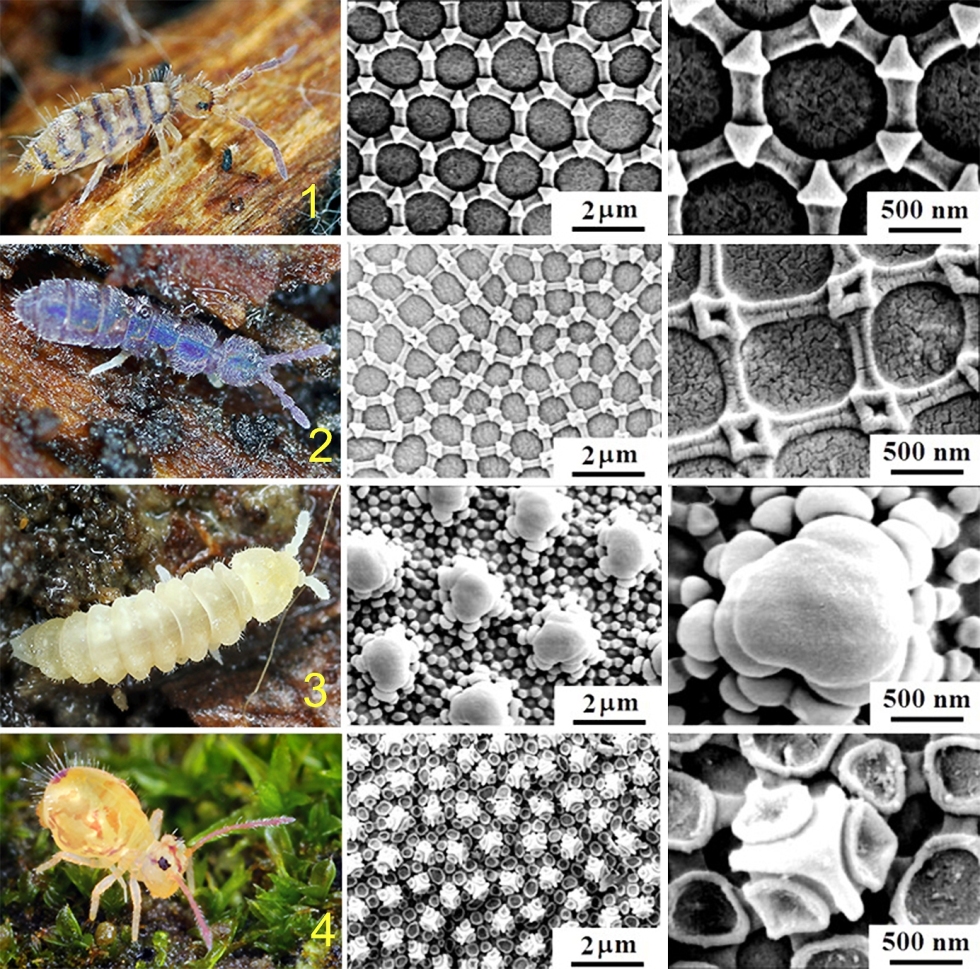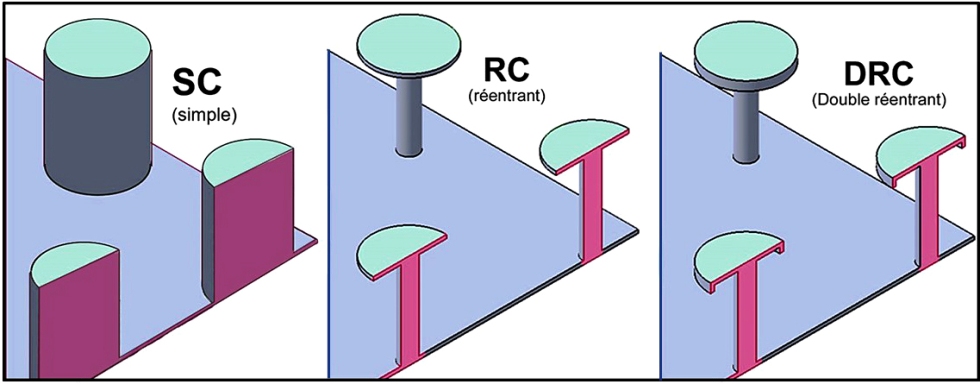Introduction:
What is the relationship between a springtail and a pipeline ?
The question may seem odd, which is why I am trying to provide some answers in this article inspired by a study1 conducted by researchers from the Science and Technology Division of King Abdullah University in Saudi Arabia. This study illustrates how the evolution of certain animals during the geological ages and under the effect of the constraints they encountered led them to acquire, among other things, morphological peculiarities which today are the subject of research that may have significant industrial benefits.
The purpose of my talk here is to show through a simple example the interest of the biomimetic approach.
Problematic:
The industries dependent on the transport of liquids through pipelines (this is particularly the case for the petroleum industry, the desalination of seawater, but also for irrigation, hydraulic fracturing or wastewater treatment) are faced with a problem of energy efficiency of their facilities, all the more impacting as the volumes transported are important. In fact, in a pipeline, the propulsive energy that is the pressure falls substantially during the transportation of the fluids because of the friction that occurs within the liquid itself but also, for a significant part, against the wall of the pipe, so that all along the route, the pressure decreases regularly. It is therefore necessary to compensate for this pressure drop by pumping units that will be positioned throughout the course of the pipe, to ensure sufficient pressure to carry fluid. The number and power of these pump groups will depend, among other things, on the friction index measured at the liquid-solid interface. For example, the attenuation of this braking effect through the use of surface treatment already makes it possible to reduce the energy (electrical, fuel, gas) consumed by the pumping units.
Technological solutions already exist, but the cost of their implementation, relative to the gain obtained, limits their use to only high value-added sectors, such as gas or oil. These solutions consist in reducing the drag effect by depositing inside the pipes polymer-based coatings which have the property of trapping micro-bubbles of air at the liquid-solid interface. However, it has been noted that these coatings are not stable over time, as evidenced, for example, by the productivity losses measured on desalination membranes. The damage they suffer is partly due to abrasion phenomena or to large temperature differences related to their conditions of use.
Note: It is clear from these observations that the ideal would be to replace these coatings whose life is limited by structures or surface microstructures of materials with identical properties while being much more stable over time.
Study :
Researchers have turned to biomimetics to copy existing solutions in nature. For this purpose, they have artificially reproduced silica microstructures which are inspired by the cuticle of collembola known for its omniphobic properties (properties of microscopic structures on which fluids slide).
Below, images taken under an electron microscope2 showing the microstructure of the cuticle of four collembola families (1): Entomobryidae. (2): Isotomidae. (3) Onychiuridae. (4) Dicyrtomidae.

The purpose of this study is to make comparative measurements from different variants of shapes and geometries in order to evaluate their characteristics.
Operating mode:
Apart from the bristles or nanoscopic patterns specific to the cuticle of some collembolans that also allow the formation of "plastron" when immersed in wetting liquids, the part of the collembola cuticle that caught the attention of researchers is the one that has cavities with pillars. Below schematic section of the three forms of pillars composing these cavities.

To highlight the properties of these structures, the researchers classify them according to three types: simple cavities (SC), reentrant cavities (RD), doubly reentrant cavities (DRC).

In order to explore more broadly the characteristics of these three types of cavities, the latter have been reproduced into five networks of different shapes. Thus, each cavity type has been declined into two hexagonal matrices, two square matrices and one circular matrix array, as shown in the sketch below.

For each of the networks, the size of the cavities D = 200 µm, their depth h = 50 µm and the cavity angle radius r = 50 µm or 3 µm.

These networks were made on silica surfaces and the liquids retained to carry out the experiments are water and hexadecane (hexadecane is a saturated hydrocarbon of the alkane family). These two choices can be related to the nature of liquids transported in the desalination and oil industries, given their physical properties, in particular vapor pressure and surface tension.
Their intrinsic contact angles on the silica (see diagram) being Φ0≈ 40° for water and Φ0≈ 20° for hexadecane.
Wetting liquids in the air:
The first survey consisted in measuring the contact angles in advance and behind drops of hexadecane and water on the different cavities (from a volume of 2µL distributed at 0.2 µL / second).
Measurements show that the silica surfaces with DRC networks (double reentrant cavities) and RC (reentrant cavities) that copy the cuticle of the collembola have all the same properties of omniphobicity in the air.
Single cavities (SC) immersed in wetting liquids:
The second investigation led to study the stability of the air trapped in the cavities during the immersion of the different surfaces of silica in hexadecane and water. The liquids were introduced at a rate of 2 ml / second until a liquid thickness of 5 mm above the samples was obtained.
Measurements showed that for hexadecane and water, single cavities of square and hexagonal shapes were filled in less than 200 milliseconds without trapping the air.
Reentrant (RC) and double-reentrant (DRC) caverns immersed in a low vapor pressure liquid:
Unlike single cavities (SC), when 5 mm hexadecane is covered with circular, square and hexagonal RC and DRC cavities, the cavities have the ability to trap and hold the air for periods ranging from a few hours until several weeks. (The mechanisms that come into action are dependent on multiple factors such as capillary pressure and surface tension described by the Young / Laplace laws ...). The imprisoned air was totally intact after 27 days, which is seven orders of magnitude greater (107) than that recorded for the surface with single cavities. Therefore, it can already be deduced that micro-textures RC and DRC type have a high propensity for trapping air under wetting liquids with low vapor pressure.
The extension of this experiment led the researchers to introduce the notion of failure named: t.failing (letter "t" for time and "failing" of English meaning "fall"), which depends on the average time taken by a wetting liquid to penetrate beyond the re-entrant or doubly re-entrant ridges and to land on the walls for more than 50 % of the cavities.
This tfailing is an essential parameter for characterizing the metastability of trapped air in micro-textured surfaces, since the specific advantages of RC er DRC are considered lost when "t.failing" is achieved.
Below, I have taken the measures of "t.failing" on the various structures studied.

Compared to RC and DRC, circular cavities (SC) are more efficient. RC and DRC cavities also achieve comparable performance.
Reentrant (RC) and reentrant (DRC) cavities immersed in a high vapor pressure liquid:
In this case, the air trapped in the cavity could be driven by capillary condensation as shown in the diagram below which concern hexagonal cavities doubly reentrant (DRC) and r = 50.mu.m.
At the beginning of the immersion, the intrusive water meniscus is stabilized at the edges and then during the 5 to 90 minutes following the capillary condensation of the water inside the cavities leads to the formation of droplets which gradually fuse together to form thick films. This volume of water displaces the air trapped in the cavity and causes an upward bulge until the water collapses in the cavity after 4 hours as shown in the last picture on the right.

During this experiment the researchers noted that the circular DRC and RC had higher scores than the DRC and RC squares and that the DRCs performed better than the CRs. They also noted that the DRCs trapped the air twice as long as the RCs (respectively 3 h to 5 h against 1.5 h to 3 h) and this, regardless of the size of the radius "r".
Other investigations compare the micro-textured silica surfaces with surfaces treated by other processes (super-hydrophilic treatment, intrinsic contact angle Φ0= 0° for the water / steam system, obtained by treatment with plasma, as well as a hydrophilic intrinsic Φ0= 40° contact angle treatment have allowed researchers to note that for liquids that establish very low contact angles Φ0≈ 0° and which are subject to capillary condensation, the biometric strategy does not allow trapping the air in the long run.
Pressure of rupture of the reentrant cavities RC and doubly reentrant :
If one is thinking of real applications of drag reduction processes inside pipelines or other circuits where wetting liquids circulate, the trapping of air must be as robust as possible. In order to quantify this aspect, the researchers compared the breaking pressures of the different micro-textures. The rupture pressure Pb is defined as the pressure from which the intruded liquid, initially stabilized on doubly reentrant edges (fig.A), penetrates more than 50% into the cavities (Fig.B).

As an indication, the breaking pressure is given by the formula: Pb = P1V1 / V2
 From statistics derived from measurements taken on about nine cavities of each type, the researchers found that the double-reentry cavities (CRD) display rupture pressures 6 to 18% higher than the corresponding reentrant cavities.
From statistics derived from measurements taken on about nine cavities of each type, the researchers found that the double-reentry cavities (CRD) display rupture pressures 6 to 18% higher than the corresponding reentrant cavities.
In the diagram below, we can see the rupture pressures (Pb) of the different structures SC, RC and DRC measured with water and a few seconds after immersion to limit the condensation effects mentioned above.
It is noted that the RC structure has no ability to retain air while RC and DRC show their full potential in this area.
Prospect:
Processes currently used in the industry for air trapping at the liquid / solid interface to reduce drag in the pipeline are essentially limited to perfluorinated coatings that are vulnerable to difficult physical, chemical and mechanical conditions. Studies on biometric microstructures (inspired by cuticle characteristics of springtails) show that they have the ability to trap air when immersed in wetting liquids without the use of chemical modifications. The RC or DRC circular geometry matrices, immersed in hexadecane, show a stabilization of the cavities allowing trapped air to remain completely intact after 27 days (and probably more, since these 27 days simply correspond to stopping experience by researchers). In contrast, single cavity silica (SC) surfaces, regardless of their geometry (circular, square or hexagonal), were filled in 0.2 seconds, a factor about 107 times shorter, making this structure ineffective .
The promising characteristics of some of these micro-structures measured on silica, make it possible to envisage an improvement of the energetic efficiencies in the pipelines if it is possible to replace the current coatings in polymers. However, the realization of such microstructures on other materials, such as plastics or metals, for industrial applications, will still require a lot of research or innovative approaches.
This is how nature opens up new ways of technological progress in its own way.
1: Biomimetic coating-free surfaces for long-term entrapment of air under wetting liquids. Autors: Eddy M. Domingues, Sankara Arunachalam, Jamilya Nauruzbayeva & Himanshu Mishra
2: Microscopic images from the study : "Superhydrophobic and superoleophobic properties in nature" Auteurs: Thierry Darmanin, Frédéric Guittard. Univ. Nice Sophia Antipolis, CNRS, LPMC, UMR 7336, 06100 Nice, France.